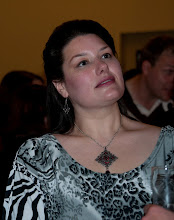Every once in a great while, I will pull out my spindle. The reasons for doing so usually have to do with the mood I'm in, the fiber I am spinning, or the state of my spinning wheel. Right now, my wheel is still loaded up with the grey corriedale fleece that I had processed from two years ago. (Got that? Two YEARS ago. I'm kinda....TIRED of it!)
So, when I picked up two gorgeous balls of swirled alpaca roving from Wooly Knob Fiber Mill, at the Michigan Fiber Festival, it was destined to be spun on my spindle for two reasons. Firstly, there's the problem of my wheel being occupied with grey corriedale. Secondly, I wanted to spin it extra-fine, which always is easier on the spindle, at least for me.
The roving is a beautiful swirl of green, blue and black, and it spins up into a lovely forest-marl.
My spindles aren't fancy at all. I don't feel the compulsion toward owning a mitt-full of fancy ones, nor do I feel unfulfilled without a fan-tabulous Golding spindle. I own two very simple Ashford spindles; one for spinning, and one for plying. Total cost for them both was probably only $25, but it hardly matters. What matters is the simplicity of using them; the connection to centuries of spinning this way, before wheels existed, before anyone knew of any other way to create a simple thread. Of course, in some parts of the world, the spindle is still the only way to spin, although we know "better" here in the Western world.
But in my case, is it really "better"? My wheel, as much as I love it, has only one ratio. It's a 5:1 wheel, which means that fine, thin yarns are a labor of love to create. On the spindle, this same fine, thin yarn is much thinner, and much finer, and much higher quality. Is it as fast as the wheel? Of course not! But that's only because I am no prize-spinner! Watch someone from the Andes spindle-spin, and you will see how fast and beautiful it can be. It's like watching poetry, really.
I try not to think of how my arms ache when I spin on the spindle. I wonder how people through the ages spun so easily, quickly, and perfectly for hours and hours. I think of how every single thread of every piece of cloth was spun this way, and here I complain of my arm and shoulder aching after a short while! Perhaps it is just the western mind; always wanting things to be easier, quicker, and without effort. We no longer have the primitive society around us where there is no other way of doing the spinning task at hand. In our world, spinning yarn really isn't even a task any longer, unless we want it to be.

So, the grey corriedale will have to wait a bit longer to get finished. I'm almost through this 4-ounce ball of alpaca roving, and I have another to go. On the wheel, it would've already long been spun up. But it would not have been spun as fine. It would not have as much character, and I would not be as intimately familiar with every strand of fiber. Drafting out each short length, I enjoy releasing my fingers to let the twist enter the loose strands. Like a little flurry of energy, the alpaca fibers swirl around the air and mesh together. I marvel at the way the twist becomes the "glue" that holds everything together. Such a simple thing, but so magical!
The whole process is a practice of patience, concentration, and timing, and yet it remains all the while absolutely relaxing. First, there is the slight pulling of the yarn to release some of the twist into the drafting zone. Next comes the first, gentle roll of the spindle against my thigh; not too much spin here, as there still isn't enough yarn made to hold onto. Draft and pull out with the new twist created, carefully holding the new yarn; catch the spindle again and roll it hard against my thigh. Higher and higher my arms go, keeping up with the twist, carefully pulling out the fiber as thin as I want it to be. Must keep watch on the spindle and make sure it doesn't stop spinning! Before I know it, a long length of fine, thin alpaca yarn is pulled out, and the spindle is nearly to the floor. Evening out the last bit of yarn I can reach to create, my right hand grabs up the spindle again, and the new yarn gets wrapped on the spindle shaft.
Before too long, the spindle begins to get too heavy with yarn; the fiber drafts unevenly, and PLUNK! My spindle drops to the floor. The yarn, broken now, has to be pieced together again, which is no problem. It's only fiber, and twist will mesh it and "glue" it again. Magic!
Over and over again, these same movements, same artful port de bras of my arms, like a dance of elegance that creates something. No wonder spindle-spinning still remains with us. No matter the fancy wheels we have, the machines, the industrial equipment. Without the spindle, we simply cannot dance in quite the same way with our fiber. The spindle is the dance, and the fiber is it's partner. A perfect match.





 Just let the fiber sit in the rinse water...I poke at mine a little bit with the spoon to help loosen things up a bit. But no agitation.
Just let the fiber sit in the rinse water...I poke at mine a little bit with the spoon to help loosen things up a bit. But no agitation.








